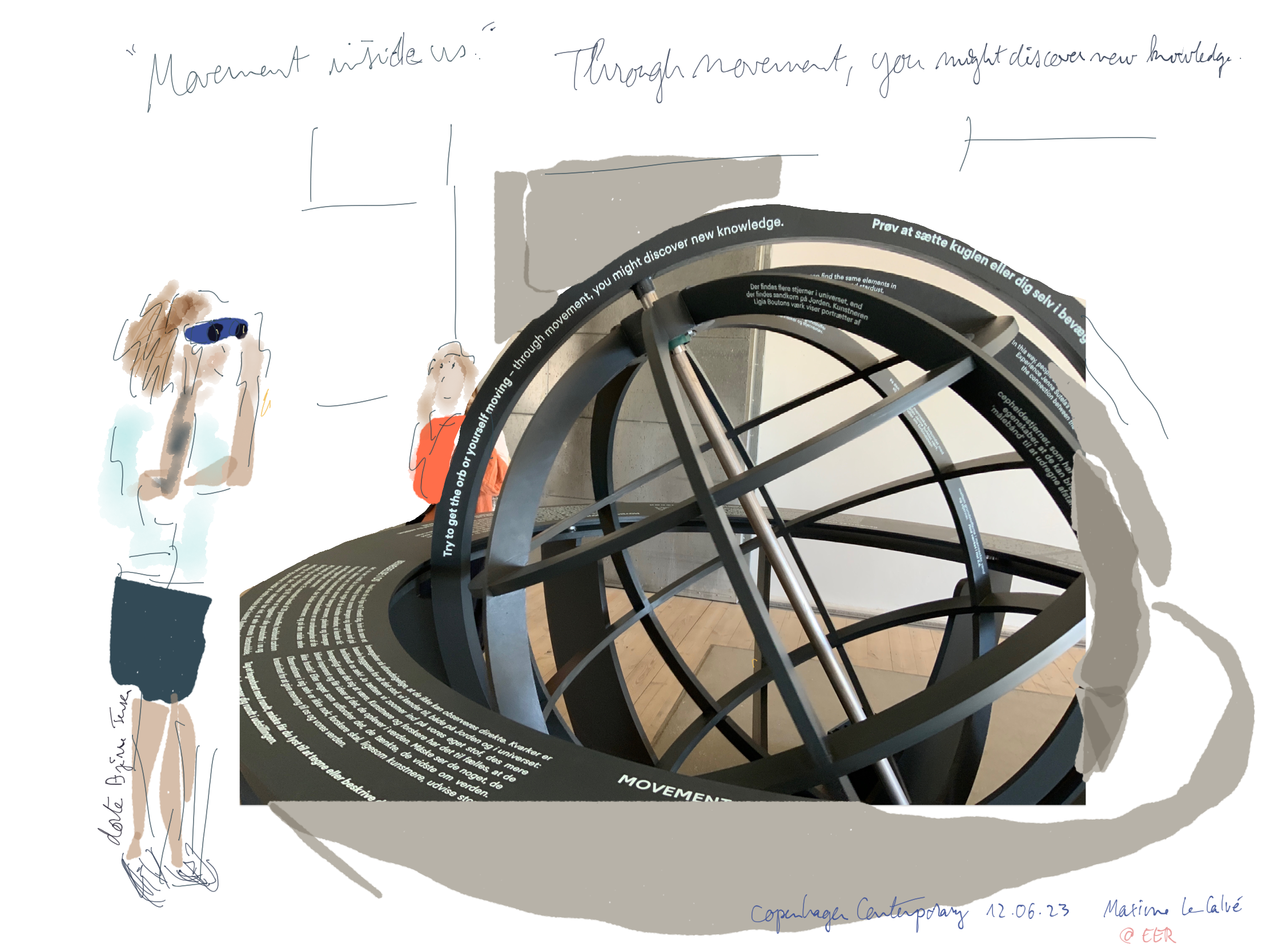Two weeks ago, I was invited in Copenhagen by the EER project (Experimenting, Experiencing, Reflecting; Olafur Eliasson Studio + Interacting Mind Center at Aarhus University) to conduct a graphic ethnographic intervention at an idea-seeding experimental workshop. Our stay there started with a tour of the newly opened “Yet, it moves!” exhibition at Copenhagen Contemporary, an ambitious art-science project that a number of EER members helped develop, curated by fantastic curator Irene Campolmi, featuring the work of the fabulous Helene Nymann, and the wizard anthropologist Joe Dumit working his good spells in the background.
In a low-key synchronicity event prefiguring some of the motion-driven mystics of the afternoon’s theme, I bumped into my new colleagues on the bus to the exhibition after a difficult train trip. The exhibition space opened recently at an ancient shipyard at the end of the bus lines. Crowds were converging there for CopenHell, a festival for heavy metal lovers. Curator Irene Campolmi opened with a line by Galileo, using a famous sentence of his as a lever, catapulting us instantly to speed: “The earth is in the center of the universe, and yet it moves!” The show brings the visitors to an estranging encounter with the perception worlds of modern science, stretching from the cosmos to the brain and back. At the tip of the artists’ fingers, science data and imaginations of matter commit with each other into cosmic assemblages. They all usher us onto a moving map of what we are in their various ways. The movement of the world – and us in it – becomes the foundation of purpose and cause, cutting together apart the lab and the studio. On the left of the sketch, one can see the piece Helene Nymann created for the show: a sculpture on a pink podium adorned with a QR code etched on brass; a video, and an inquiring web device. That work wants the visitors to remember what to remember. Their remembrances are then located on the “carte de tendre.”
There is a heavy orb in the lobby that moves smoothly. Try and set it in motion: the model of the world becomes an empty form that takes meaning only through the dynamic flows of perspective it enables. “Try to get the orb or yourself moving – through movement, you might discover new knowledge.” The pulsations inside us are brought in direct continuity with the vibrance of the universe. Dorte reaches for the binoculars and sets her gaze in motion – a shivering focus can bring things to dance again.
Datastreams flood through us in the ultra-high-definition audio-video installation of Ryoji Ikeda. The piece Dataverse is displayed in a huge room on three panes, three acts of a spacetime opera shown simultaneously with bombastic data sound triggering macroscopic unfoldings of picture matters throughout cosmos bodies. The feeling of awe turned us momentaneously into a Wagnerian audience process, sitting on the hard floor in the dark. A few members of EER, more inclined to keep moving, probed the work very close up, meeting with the pixels and disrupting the illusion.
The next piece was also monumental as a projection of monumental proportions. It showed us the inside of a glacier’s “throat” shortly before its collapse. Jakob Kudsk Steensen scanned the mighty being and presents video footage, points, and meshes, juxtaposing them into an intricate inner landscape. “My parents were mountaineers,” a subtitle told us as the subwoofers hummed deep subglacial tones. Everything else was dark save for the doorstep to the next enlightening experience.
The next piece was the much expected carte de tendre “Futur Continuous” video poetic piece of Helene Nymann. “Maybe the future is a memory you can remember, something you don’t want to be repeated.” “It’s time to draw a new map.” Situating us into an emotion landscape was an innovation of a female writer in the 17th century: together with friends, they invented a way to place the itinerary of a love journey. Helene crops out the map with a generative AI to remember the future of our human voyage. She stages herself and others into a dark loving affair with our grim perspectives and what we will leave ahead of us. What we will remember of the future. “Try to remember how your memory will make the future feel.”
The last piece of the show is a thinking bowl. The “Brain Pond” by Jenna Sutela is inviting the visitors to touch its rims and the water is keeps. A microphone picks the sound of it, mixed with sounds of prior interactions and whales and cosmos. The sound is not as “live” as the intrically written concept announces it, which makes the piece if yet interactive perhaps more uniformoulsy evocative of cosmic ripples and neural sparks. Kids love to touch its ears, Irene tells us, and we touched and tried to get the heavy brass bowl to sing.
“Yet, it moves!” points at the rich experiential world of science. Movement is one of the ways It is be deeply erroneous to think science worlds as disenchanted and waiting for the intervention of the artist or humanity scholar to reenchant them, as Natasha Myers points out in her ethnographic notes on how biologists encounter plant-sensing (2015). Much like the popular physics writing on quantum in the 1980s and 1990s, this exhibition pays attention to the emergence of new contemporary languages to articulate mystic experiences between science and art, into slightly grim future that still believe in human potential.





